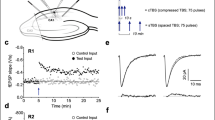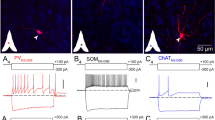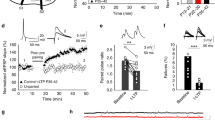Abstract
Long-term potentiation (LTP) of synaptic transmission following brief trains of high-frequency stimulation in hippocampal pathways has attracted attention as a possible physiological correlate of memory. The mechanism of LTP is little understood, and what evidence there is suggests that both pre- and postsynaptic mechanisms are involved1–7. Previous findings that Ca2+ is required for LTP8,9, and that LTP is accompanied by a prolonged increased in Ca2+ uptake10, suggest that an increase in impulse-dependent release of transmitter, a process critically dependent on presynaptic Ca2+ levels11,12, may be an important component of this form of synaptic plasticity. A recent report13 that release of previously accumulated 3H-D-aspartate is increased following tetanic stimulation of afferent fibres to CA1 pyramidal cells in hippocampal slices is also consistent with a presynaptic mechanism. However, there has been no direct evidence relating LTP to an increased stimulus-dependent release of transmitter. We have now investigated whether LTP in the perf orant path (PP) of the rat is associated with a change in the release of neurotransmitter. A modification of the push-pull cannula technique has enabled us to infuse 3H-glutamine and measure the subsequent release of newly synthesized 3H-glutamate, and at the same time to monitor the field potentials evoked in the dentate gyrus by stimulation of the PP. We have found a prolonged increase in the release of glutamate, the probable transmitter of the PP14,15, following the induction of LTP in this pathway.
This is a preview of subscription content, access via your institution
Access options
Subscribe to this journal
Receive 51 print issues and online access
$199.00 per year
only $3.90 per issue
Buy this article
- Purchase on Springer Link
- Instant access to full article PDF
Prices may be subject to local taxes which are calculated during checkout
Similar content being viewed by others
References
Bliss, T. V. P. & Lømo, T. J. Physiol., Lond. 232, 331–356 (1973).
Andersen, P., Sundberg, S. H., Sveen, O., Swann, J. W. & Wigström, H. J. Physiol., Lond. 302, 463–482 (1980).
Dunwiddie, T. & Lynch, G. J. Physiol., Lond. 276, 353–367 (1978).
van Harreveld, A. & Fifková, E. Expl Neurol. 49, 736–749 (1975).
Baudry, M., Bundman, M. C., Smith, E. K. & Lynch, G. S. Science 212, 937–938 (1981).
Browning, M., Bennett, W. F., Kelly, P. & Lynch, G. Brain Res. 218, 255–266 (1981).
McNaughton, B. L., Douglas, R. M. & Goddard, G. V. Brain Res. 157, 277–293 (1978).
Dunwiddie, T., Madison, D. & Lynch, G. Brain Res. 150, 413–417.
Wigström, H., Swann, J. W. & Andersen, P. Acta physiol. scand. 105, 126–128 (1979).
Baimbridge, K. G. & Miller, J. J. Brain Res. 221, 299–305 (1981).
Dodge, F. A. & Rahamimoff, R. J. Physiol., Lond. 193, 419–432 (1967).
Katz, B. & Miledi, R. J. Physiol., Lond. 216, 503–512 (1971).
Skrede, K. K. & Malthe-Sørenssen, D. Brain Res. 208, 436–441 (1981).
Storm-Mathisen, J. Adv. Biochem. Psychopharmac. 27, 43–53 (1981).
Nadler, J. V. & Smith, E. M. Neurosci. Lett. 25, 275–280 (1981).
Lømo, T. Expl Brain Res. 12, 18–45 (1971).
Bradford, H. & Ward, H. K. Brain Res. 110, 115–125 (1976).
Bradford, H., Ward, H. K. & Thomas, A. J. J. Neurochem. 30, 1453–1459 (1978).
Hamberger, A., Chiang, G. H., Sandoval, M. E. & Cotman, C. W. Brain Res. 168, 513–530 (1979).
Reubi, J.-C., Van der Berg, C. & Cuénod, M. Neurosci. Lett. 10, 171–174 (1978).
Dolphin, A. C. Brain Res. (in the press).
Reubi, J.-C. Neuroscience 5, 2145–2150 (1980).
Author information
Authors and Affiliations
Rights and permissions
About this article
Cite this article
Dolphin, A., Errington, M. & Bliss, T. Long-term potentiation of the perforant path in vivo is associated with increased glutamate release. Nature 297, 496–497 (1982). https://doi.org/10.1038/297496a0
Received:
Accepted:
Issue Date:
DOI: https://doi.org/10.1038/297496a0
This article is cited by
-
Effects of carnosine on long-term plasticity of medial perforant pathway/dentate gyrus synapses in urethane-anesthetized rats: an in vivo model
Experimental Brain Research (2009)
-
Ionotropic glutamate receptors
Molecular Neurobiology (1996)
-
Activation of postsynaptically silent synapses during pairing-induced LTP in CA1 region of hippocampal slice
Nature (1995)
Comments
By submitting a comment you agree to abide by our Terms and Community Guidelines. If you find something abusive or that does not comply with our terms or guidelines please flag it as inappropriate.



